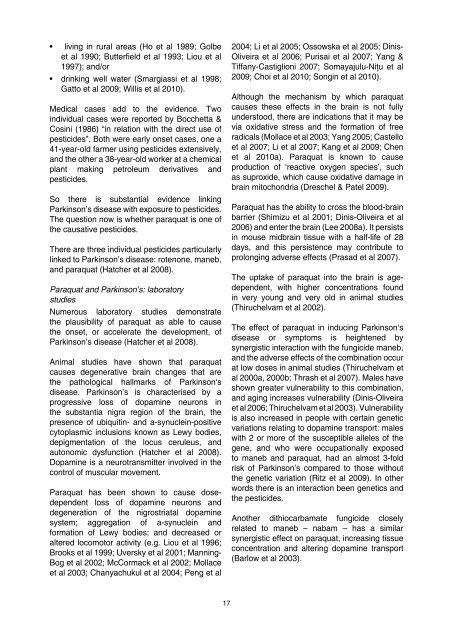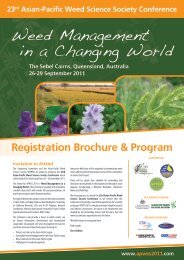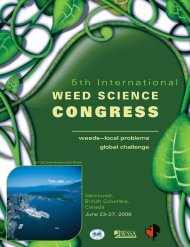PARAQUAT
PARAQUAT
PARAQUAT
You also want an ePaper? Increase the reach of your titles
YUMPU automatically turns print PDFs into web optimized ePapers that Google loves.
• living in rural areas (Ho et al 1989; Golbe<br />
et al 1990; Butterfield et al 1993; Liou et al<br />
1997); and/or<br />
• drinking well water (Smargiassi et al 1998;<br />
Gatto et al 2009; Willis et al 2010).<br />
Medical cases add to the evidence. Two<br />
individual cases were reported by Bocchetta &<br />
Cosini (1986) “in relation with the direct use of<br />
pesticides”. Both were early onset cases, one a<br />
41-year-old farmer using pesticides extensively,<br />
and the other a 38-year-old worker at a chemical<br />
plant making petroleum derivatives and<br />
pesticides.<br />
So there is substantial evidence linking<br />
Parkinson’s disease with exposure to pesticides.<br />
The question now is whether paraquat is one of<br />
the causative pesticides.<br />
There are three individual pesticides particularly<br />
linked to Parkinson’s disease: rotenone, maneb,<br />
and paraquat (Hatcher et al 2008).<br />
Paraquat and Parkinson’s: laboratory<br />
studies<br />
Numerous laboratory studies demonstrate<br />
the plausibility of paraquat as able to cause<br />
the onset, or accelerate the development, of<br />
Parkinson’s disease (Hatcher et al 2008).<br />
Animal studies have shown that paraquat<br />
causes degenerative brain changes that are<br />
the pathological hallmarks of Parkinson‘s<br />
disease. Parkinson’s is characterised by a<br />
progressive loss of dopamine neurons in<br />
the substantia nigra region of the brain, the<br />
presence of ubiquitin- and a-synuclein-positive<br />
cytoplasmic inclusions known as Lewy bodies,<br />
depigmentation of the locus ceruleus, and<br />
autonomic dysfunction (Hatcher et al 2008).<br />
Dopamine is a neurotransmitter involved in the<br />
control of muscular movement.<br />
Paraquat has been shown to cause dosedependent<br />
loss of dopamine neurons and<br />
degeneration of the nigrostriatal dopamine<br />
system; aggregation of a-synuclein and<br />
formation of Lewy bodies; and decreased or<br />
altered locomotor activity (e.g. Liou et al 1996;<br />
Brooks et al 1999; Uversky et al 2001; Manning-<br />
Bog et al 2002; McCormack et al 2002; Mollace<br />
et al 2003; Chanyachukul et al 2004; Peng et al<br />
2004; Li et al 2005; Ossowska et al 2005; Dinis-<br />
Oliveira et al 2006; Purisai et al 2007; Yang &<br />
Tiffany-Castiglioni 2007; Somayajulu-Nițu et al<br />
2009; Choi et al 2010; Songin et al 2010).<br />
Although the mechanism by which paraquat<br />
causes these effects in the brain is not fully<br />
understood, there are indications that it may be<br />
via oxidative stress and the formation of free<br />
radicals (Mollace et al 2003; Yang 2005; Castello<br />
et al 2007; Li et al 2007; Kang et al 2009; Chen<br />
et al 2010a). Paraquat is known to cause<br />
production of ‘reactive oxygen species’, such<br />
as suproxide, which cause oxidative damage in<br />
brain mitochondria (Dreschel & Patel 2009).<br />
Paraquat has the ability to cross the blood-brain<br />
barrier (Shimizu et al 2001; Dinis-Oliveira et al<br />
2006) and enter the brain (Lee 2008a). It persists<br />
in mouse midbrain tissue with a half-life of 28<br />
days, and this persistence may contribute to<br />
prolonging adverse effects (Prasad et al 2007).<br />
The uptake of paraquat into the brain is agedependent,<br />
with higher concentrations found<br />
in very young and very old in animal studies<br />
(Thiruchelvam et al 2002).<br />
The effect of paraquat in inducing Parkinson‘s<br />
disease or symptoms is heightened by<br />
synergistic interaction with the fungicide maneb,<br />
and the adverse effects of the combination occur<br />
at low doses in animal studies (Thiruchelvam et<br />
al 2000a, 2000b; Thrash et al 2007). Males have<br />
shown greater vulnerability to this combination,<br />
and aging increases vulnerability (Dinis-Oliveira<br />
et al 2006; Thiruchelvam et al 2003). Vulnerability<br />
is also increased in people with certain genetic<br />
variations relating to dopamine transport: males<br />
with 2 or more of the susceptible alleles of the<br />
gene, and who were occupationally exposed<br />
to maneb and paraquat, had an almost 3-fold<br />
risk of Parkinson’s compared to those without<br />
the genetic variation (Ritz et al 2009). In other<br />
words there is an interaction been genetics and<br />
the pesticides.<br />
Another dithiocarbamate fungicide closely<br />
related to maneb – nabam – has a similar<br />
synergistic effect on paraquat, increasing tissue<br />
concentration and altering dopamine transport<br />
(Barlow et al 2003).<br />
17




